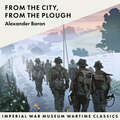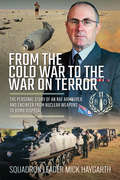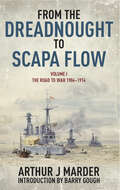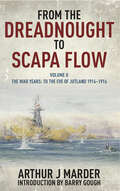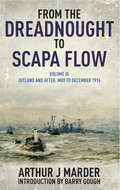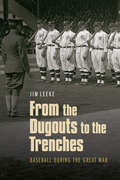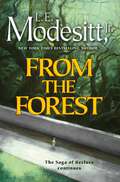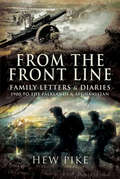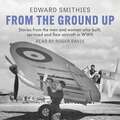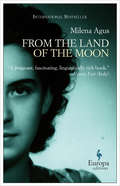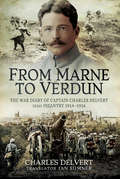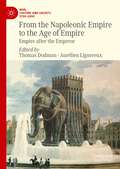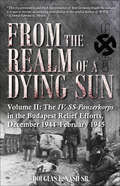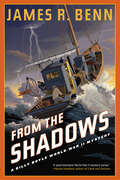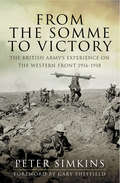- Table View
- List View
From the City, From the Plough: Imperial War Museum Wartime Classics
by Alexander BaronSpring 1944, the south coast of England. The Fifth Battalion, Wessex Regiment, wait patiently and nervously for the order to embark. There is boredom and fear, comedy and pathos as the men all drawn from different walks of life await the order to move.With an economy of language that belies its emotional impact, From the City, From the Plough is a vivid and moving account of the fate of these men as they embark for the beaches of Normandy and advance into France, where the battalion suffers devastating casualties.Based on Alexander Baron's own wartime experience, From the City, From the Plough was originally published to wide acclaim and reportedly sold over one million copies. This new edition of the 1948 classic includes a contextual introduction from IWM which sheds new light on the dramatic true events that so inspired its author.(P)2019 Headline Publishing Group Ltd
From the Cold War to the War on Terror: The Personal Story of an RAF Armourer and Engineer from Nuclear Weapons to Bomb Disposal
by Mick HaygarthA bomb-disposal expert shares stories from conflict zones ranging from the Falklands to Kosovo to Iraq.Michael Haygarth left home just before his seventeenth birthday to join the Royal Air Force as a Weapons Technician. At the time, everything seemed routine—but his thirty-eight-year career turned out to be anything but. Training with nations all over the world; fast roping out of helicopters with US Army Rangers; being driven around Basra in a beaten-up taxi wearing civilian clothes with a 9mm pistol in his waistband; convoying at speed around Baghdad with the US Army looking for unexploded bombs—all were way beyond the usual experiences of an RAF Engineer.In his early career, he was a member of a Buccaneer Nuclear Weapon Loading Team stationed in RAF Germany at the height of the Cold War. Frequently woken by sirens in the early morning hours, he’d rush to work wondering if it was yet another practice or the start of nuclear Armageddon. After further tours, and having passed his Bomb Disposal courses, he was then sent to the Falkland Islands. He also served in Kosovo as part of a huge multinational force tasked with clearing thousands of bombs and cluster munitions, as well as working with the International Crimes Tribunal to clear numerous mass graves. He was responsible for all UK Bomb Disposal operations in and around Pristina.Next came an operational tour to Iraq, where he made further use of his bomb disposal expertise. After promotion to Squadron Leader, he worked in the Ministry of Defense and then took charge of the RAF’s only Bomb Disposal Squadron as it withdrew from Iraq, and was instrumental in refocusing the squadron to carry out operations in Afghanistan alongside the Army. His final role, in what was a truly exceptional career, was in charge of the RAF’s only expeditionary Engineering Squadron as it worked through the busiest period in its history during the UK forces’ withdrawal from Afghanistan and the escalation of events in support of operations in the Baltic states and Syria. In this book, he tells his remarkable story.
From the Dardanelles to Oran: Studies of the Royal Navy in War and Peace, 1915–1914
by Arthur J. MarderThis collection of thought-provoking essays by arguably the 20th century's greatest naval historian was first published in 1974, but their continuing relevance fully justifies this reprint. It opens with a stimulating reappraisal of the naval attack on the Dardanelles, the success of which would have made the disastrous Gallipoli land campaign that followed completely unnecessary. Marder identifies a number of relatively minor issues that made a failure of what was in reality a great strategic opportunity to shorten the war. Other chapters cover what the Royal Navy did and did not learn from the Great War, and Churchill's controversial time at the Admiralty before he became Prime minister in 1940, while Marder's analysis of the inter-war Ethiopian Crisis asking whether military aggression can be countered by sanctions has powerful echoes of current political concerns. The final essay looks at one of the most contentious episodes of the Second World War, the British pre-emptive strike on the fleet of their one-time allies at Oran after the French surrender in 1940.Because Marder's view of history emphasises the human dimension over abstract forces, his work is always approachable in style and of as much interest to the layman as the professional historian. This book is no exception.
From the Depths
by Gerry DoyleDr. Christine Myers, a forensic scientist with the CIA, has investigated some of the most heinous crimes ever committed, but nothing could prepare her for the slaughter aboard the Dragon, a defecting North Korean nuclear submarine. On board, Christine and a team of Navy SEALs find all the crew members dead, some with their bodies smashed and mutilated, others poisoned from chlorine gas inhalation. Was the gas leak an accident, or was it sabotage? As the SEALS submerge the sub and attempt a clandestine journey to land, Christine tries to piece together the forensic clues. But once the SEALs start dying one by one, the survivors must band together against an unseen enemy—before it&’s too late.
From the Don to the Dnepr: Soviet Offensive Operations, December 1942 - August 1943 (Soviet (Russian) Military Experience #Vol. 1)
by David M. GlantzThis book provides an in-depth study of the Soviet Army during the offensive operations that started with Battle of Stalingrad in December 1942 and went until Spring 1943. The lessons learned by the Soviet Army from these experiences helped design the military steamroller that decimated the German panzer divisions at Kursk in the Summer of 1943.
From the Dreadnought to Scapa Flow, Volume I: The Road to War 1904–1914 (From The Dreadnought To Scapa Flow Ser.)
by Arthur Marder“A masterpiece . . . an indispensable source on the Royal Navy’s development in the decade before the First World War.” —War in HistoryThe five volumes that constitute Arthur Marder’s From the Dreadnought to Scapa Flow represented arguably the finest contribution to the literature of naval history since Alfred Mahan. A. J. P. Taylor wrote that “his naval history has a unique fascination. To unrivalled mastery of sources he adds a gift of simple narrative . . . He is beyond praise, as he is beyond cavil.”The five volumes were subtitled The Royal Navy in the Fisher Era, 1904–1919 and they are still, despite recent major contributions from Robert Massie and Andrew Gordan, regarded by many as the definitive history of naval events leading up to and including the Great War. This first volume covers many facets of the history of the Royal Navy during the pre-war decade, including the economic and political background such as the 1906 Liberal Government hostility towards naval spending. Inevitably, however, attention moves to the German naval challenge, the arms race and the subsequent Anglo-German rivalry, and, finally, the British plans for the blockade of the German High Seas Fleet. A new introduction by Barry Gough, the distinguished Canadian maritime and naval historian, assesses the importance of Marder’s work and anchors it firmly amongst the great naval narrative histories of this era.This ebook edition will bring a truly great work to a new generation of historians and general readers.“[An] extensive and masterly classic work of the Royal Navy in the Great War. A prodigious work of scholarship.” —Scuttlebutt (Friends of the RN Museum)
From the Dreadnought to Scapa Flow, Volume II: To The Eve of Jutland 1914–1916 (From The Dreadnought To Scapa Flow Ser.)
by Arthur MarderThe five volumes that constitute Arthur Marder's From the Dreadnought to Scapa Flow represented arguably the finest contribution to the literature of naval history since Alfred Mahan. A J P Taylor wrote that 'his naval history has a unique fascination. To
From the Dreadnought to Scapa Flow, Volume III: Jutland and After May to December 1916 (From The Dreadnought To Scapa Flow Ser.)
by Arthur J. MarderVolume III in this definitive WWI naval history presents an in-depth analysis of the Battle of Jutland, with a new introduction by historian Barry Gough. Arthur Marder's five-volume history From the Dreadnought to Scapa Flow is one of the finest contributions to naval history, chronicling the dramatic conflicts of the First World War with an &“unrivalled mastery of sources&” and &“a gift of simple narrative&” (A.J.P. Taylor). The third volume presents an in-depth analysis of the clash between the German High Seas fleet and the British Grand Fleet and Battlecruiser Fleet at Jutland, as well as its immediate aftermath. Marder's intricate charting of this great battle is still recognized as the authoritative statement on these events. A new introduction by Barry Gough, the distinguished Canadian maritime and naval historian, assesses the importance of Marder's work and anchors it firmly amongst the great naval narrative histories of this era.
From the Dugouts to the Trenches: Baseball during the Great War
by Jim LeekeBaseball, like the rest of the country, changed dramatically when the United States entered World War I, and Jim Leeke brings these changes to life in From the Dugouts to the Trenches. He deftly describes how the war obliterated big league clubs and largely dismantled the Minor Leagues, as many prominent players joined the military and went overseas. By the war’s end more than 1,250 ballplayers, team owners, and sportswriters would serve, demonstrating that while the war was “over there,” it had a considerable impact on the national pastime. Leeke tells the stories of those who served, as well as organized baseball’s response, including its generosity and patriotism. He weaves into his narrative the story of African American players who were barred from the Major Leagues but who nevertheless swapped their jerseys for fatigues, as well as the stories of those who were killed in action—and by diseases or accidents—and what their deaths meant to teammates, fans, and the sport in general.From the Dugouts to the Trenches illuminates this influential and fascinating period in baseball history, as nineteen months of upheaval and turmoil changed the sport—and the world—forever.
From the Forest (Saga of Recluce #23)
by L. E. Modesitt Jr.L. E. Modesitt, Jr. continues the Saga of Recluce, the long-running, best-selling epic fantasy series. In a new story arc, From the Forest follows the early life of a man known by many names depending on who you ask—hero, tyrant, emperor.Alayiakal, who will one day be known by many names —not all of them flattering—has to climb the ranks of Cyador’s Mirror Lancers, fighting against unforeseen weapons and ancient technology.Alayiakal, however, has secrets of his own to protect: his ties to the Great Forest and his magus abilities. He must silently pretend to be a conventional soldier favored by fate—until that very same fate forces him to choose.Saga of Recluce#1 The Magic of Recluce / #2 The Towers of the Sunset / #3 The Order War / #4 The Magic Engineer / #5 The Death of Chaos / #6 Fall of Angels / #7 The Chaos Balance / #8 The White Order / #9 Colors of Chaos / #10 Magi’i of Cyador / #11 Scion of Cyador / #12 Wellspring of Chaos / #13 Ordermaster / #14 Natural Order Mage / #15 Mage-Guard of Hamor / #16 Arms-Commander / #17 Cyador’s Heirs / #18 Heritage of Cyador / #19 The Mongrel Mage / #20 Outcasts of Order / #21 The Mage-Fire War / #22 Fairhaven Rising/#23 From the ForestStory Collection: Recluce TalesOther Series by L.E. Modesitt, Jr.The Grand IllusionThe Imager PortfolioThe Corean ChroniclesThe Spellsong CycleThe Ghost BooksThe Ecolitan MatterAt the Publisher's request, this title is being sold without Digital Rights Management Software (DRM) applied.
From the Frontline: Family Letters and Diaries: 1900 to the Falklands and Afghanistan
by Hew PikeFrom the Frontline is an extraordinary record of a familys military service over the last 100 years. Thanks to careful editing, each individual tells his story through letters and diaries which capture the military scene and reflect family ties that bind them all closely. The eight family members served in South Africa, West Africa, Korea, Aden, the Falklands and Afghanistan as well as both World Wars. One lost his life and others were wounded. Two became generals, many were decorated. Their records may span a century when warfare changed greatly. Yet the tone of the letters remains surprisingly constant reflecting confidence in their fellows, a pride in service to Crown and Country, love of family and understatement of the dangers. Being thinking men, their views on the conduct of operations is sometimes critical as are their opinions of their leaders. This collection is highly unusual and totally enthralling.
From the Grand Canal to the Dodder: Illustrious Lives
by Beatrice M. DoranThe Dublin suburbs situated between the Grand Canal and the River Dodder consist of distinct neighbourhoods, each with their own character and style. It is an area that was, and continues to be, home to poets, writers, artists, politicians and academics, all of whom, in their own way, contributed to Irish life. Those featured include: Jack B. Yeats, artist; Mother Mary Aikenhead, Founder of the Religious Order; Brendan Behan, writer and dramatist; Mary Lady Heath, aviator and international athlete; Sophie Bryant, mathematician, educationist and suffragette; James Franklin Fuller, architect and Seamus Heaney, poet. In this book, Dr Beatrice M. Doran tells of the lives of some of the most fascinating people who once lived on the leafy roads and avenues of this interesting area of the city.
From the Ground Up: Stories from the men and women who built, serviced and flew aircraft in WWII (W&N Military)
by Edward Smithies'Fascinating ... this collection illuminates corners of the wartime world ... it provides a valuable and often entertaining window' GUARDIAN'The horrors have not been suppressed. Everyone who speaks was very young then. You sense their wonder that they did the things they recall' INDEPENDENT ON SUNDAYWhen we remember the Second World War in the air, we think of fighter pilots and bomber crews. But what was it like for the men and women working as ground crew and in the aircraft factories who also played a crucial role in defeating Hitler? What was it like making history? What sense did these individuals have of what they were doing, either at the time or later? Did they feel they were caught up in the tide of great events? Or were they simply doing their demanding and often dangerous duty?Originally published as ACES, ERKS AND BACKROOM BOYS
From the Ground Up: The Story of “Brother Van”, Montana Pioneer Minister, 1848-1919
by Robert W. LindThis book, which was first published in 1961, is a biography of Rev. William Wesley Van Orsdel (1848-1919), known as “Brother Van”, a Methodist circuit rider in Montana who made a significant contribution to the spread of Methodism in Montana and the early development of the state’s public institutions. Throughout his career, Brother Van founded churches, universities, and hospitals; he converted and ministered to homesteaders, miners, and Native Americans; he worked with the elites and the poor, the famous and the forgotten in a career that spanned nearly 50 years.“To paint a word picture of the pioneer preacher and the pioneer territory which captures the real feeling which Brother Van had for Montana and which Montana had for Brother Van is almost impossible. But Bob Lind, a part of the Church which Brother Van helped to establish, has come closer than any writer to date.“Lind’s picture of Brother Van and his times is reliably accurate, though it was no easy task to detach fact from fiction in giving account of a man about whom stories grew like grass on the Montana prairie. He found in Brother Van’s life so much adventure and color that he only needed to tell the story as it was.“When you finish reading this book you will have met the best of the early frontier in the Rocky Mountain west. You will follow a man who made a pulpit for preaching the Good News out of the freighter’s or cowboy’s camp, the cabin or the ranch home, the Indian tepee, the barroom or the street corner. And you will see that to all of his congregations, formal or informal, he always gave his best in word and song.”—George A. Harper, Foreword
From the Imjin to the Hook: A National Service Gunner in the Korean War
by James JacobsThe British Armys considerable contribution to The Korean War 1950 1953 was largely composed of conscripts or national servicemen. Plucked from civilian life on a lottery basis and given a short basic training, some like Jim Jacobs volunteered for overseas duty and suddenly found themselves in the thick of a war as intensive and dangerous as anything the Second World War had had to offer.As a member of 170 Independent Mortar Battery RA from March 1951 to June 1952 Jim was in the frontline at the famous Battle of the Imjin River. By great luck, he evaded capture and death unlike so many. He returned to the UK only to volunteer again for a second tour with 120 Light Battery from March 1953 to March 1954. During this period, he was in the thick of the action at the Third Battle of the Hook during May 1953.In this gripping memoir, Jim calmly and geographically recounts his experiences and emotions from joining the Army through training, the journeys by troopship and, most importantly, on active service in the atrocious and terrifying war fighting that went on in a very foreign place.
From the Land of Shadows: War, Revolution, and the Making of the Cambodian Diaspora (Nation of Nations #14)
by Khatharya UmIn a century of mass atrocities, the Khmer Rouge regime marked Cambodia with one of the most extreme genocidal instances in human history. What emerged in the aftermath of the regime's collapse in 1979 was a nation fractured by death and dispersal. It is estimated that nearly one-fourth of the country's population perished from hard labor, disease, starvation, and executions. Another half million Cambodians fled their ancestral homeland, with over one hundred thousand finding refuge in America.From the Land of Shadows surveys the Cambodian diaspora and the struggle to understand and make meaning of this historical trauma. Drawing on more than 250 interviews with survivors across the United States as well as in France and Cambodia, Khatharya Um places these accounts in conversation with studies of comparative revolutions, totalitarianism, transnationalism, and memory works to illuminate the pathology of power as well as the impact of auto-genocide on individual and collective healing. Exploring the interstices of home and exile, forgetting and remembering, From the Land of Shadows follows the ways in which Cambodian individuals and communities seek to rebuild connections frayed by time, distance, and politics in the face of this injurious history.
From the Land of the Moon
by Milena Agus“Powerful . . . The vivid descriptions of the Sardinian landscape are a fitting complement to the heroine’s conflicted heart” (Kirkus Reviews, starred review).As this compelling novel opens, a young unnamed woman reflects on the life of her bewitching, eccentric, and fiercely emotional grandmother, whose abiding search for love spans much of the twentieth century. In 1943, as American bombs fall on the city of Cagliari, she is thirty and considered an old maid, still living at home with her parents. But when the bombing ceases, and despite her protests, her father forces her to marry the first man to propose, an older widower she doesn’t love. After suffering several miscarriages, she is sent for treatment at a spa on the mainland, where she falls in love with an injured Italian army veteran. Back home, she gives birth to a son. She never reveals the affair to her husband—but decades later, she returns to the mainland and travels to her former lover’s hometown of Milan. Dressed in her finest coat and shoes, she wanders the streets in search of the elusive veteran . . .Set against a backdrop of rugged mountains and Italian villages lost in time, this international bestselling novel is a multigenerational family saga about love, lust, and country.“Agus’s descriptions of the everyday are as beautiful and haunting as her portrayal of life’s most dramatic episodes. Add an unexpected ending and the result is a graceful, powerful book.” —Publishers Weekly (starred review)
From the Marne to Verdun: The War Diary of Captain Charles Delvert, 101st Infantry, 1914–1916
by Charles DelvertCharles Delverts diary records his career as a front-line officer in the French army fighting the Germans during the First World War. It is one of the classic accounts of the war in French or indeed in any other language, and it has not been translated into English before. In precise, graphic detail he sets down his wartime experiences and those of his men. He describes the relentless emotional and physical strain of active service and the extraordinary courage and endurance required in battle. His account is essential reading for anyone who is keen to gain a direct insight into the Great War from the French soldier's point of view, and it bears comparison with the best-known English and German memoirs and journals of the Great War.
From the Marne to Verdun: The War Diary of Captain Charles Delvert, 101st Infantry, 1914–1916
by Charles DelvertCharles Delverts diary records his career as a front-line officer in the French army fighting the Germans during the First World War. It is one of the classic accounts of the war in French or indeed in any other language, and it has not been translated into English before. In precise, graphic detail he sets down his wartime experiences and those of his men. He describes the relentless emotional and physical strain of active service and the extraordinary courage and endurance required in battle. His account is essential reading for anyone who is keen to gain a direct insight into the Great War from the French soldier's point of view, and it bears comparison with the best-known English and German memoirs and journals of the Great War.
From the Napoleonic Empire to the Age of Empire: Empire after the Emperor (War, Culture and Society, 1750–1850)
by Thomas Dodman Aurélien LignereuxThis book explores imperial entanglements to reassess the Napoleonic Empire as a missing link—or at least an important chain—in the global and longue durée history of Empires. In recent years Napoleonic studies have, belatedly but resolutely, embraced the transnational historiographical turn, vastly expanding the field’s geographical scope. Its canonical chronological boundaries, on the other hand, appear increasingly narrow against this wider backdrop, giving the impression of a parenthetical, almost anachronistic aside from 1799 to 1815. What connects, and what doesn’t connect, the Napoleonic Empire to the Age of Empire, remains by and large an open question. Put another way, this book attempts to locate the Napoleonic empire in World History.
From the Realm of a Dying Sun: The IV. SS-Panzerkorps in the Budapest Relief Efforts, December 1944–February 1945
by Douglas E. Nash Sr.“A veritable tour de force of Eastern Front armored combat replete with slashing counterattacks, defending to the last man, and overcoming odds.” —Mark J. Reardon, author of Victory at MortainOn Christmas Eve 1944, the men of the IV. SS-Panzerkorps and its two divisions—the 3rd SS Panzer Division “Totenkopf” and the 5th SS Panzer Division “Wiking”—were eagerly anticipating what the holiday would bring, including presents from home and perhaps sharing a bottle of schnapps or wine with their comrades.This was not to be, for that very evening, the corps commander, SS-Obergruppenführer Herbert Otto Gille, received a telephone call notifying him that the 35,000 men of his corps would begin boarding express trains the following day that would take them from the relative quiet of the Vistula Front to the front lines in Hungary, hundreds of kilometers away. Their mission: Relieve Budapest! Thus would begin the final round in the saga of the IV. SS-Panzerkorps. In Hungary, it would play a key role in the three attempts to raise the siege of that fateful city. Threatened as much by their high command as by the forces of the Soviet Union, Gille and his troops overcame seemingly insurmountable obstacles in their attempts to rescue the city’s garrison, only to have their final attack called off at the last minute. At that moment, they were only a few kilometers away from the objective towards which they had striven for nearly a month. After the relief attempt’s failure sealed the fate of hundreds of thousands of Hungarians and Germans, the only course of action remaining was to dig in and protect the Hungarian oilfields as long as possible.
From the Shadows (A Billy Boyle WWII Mystery #17)
by James R. BennIn southern France in 1944, Captain Billy Boyle works with French Resistance fighters to protect a Royal Navy Commander, uncovering a wide web of subterfuge and betrayal in the process.Southern France, 1944: What should be a simple assignment with a Special Operations Executive officer gets complicated quickly as Billy navigates the tensions between Resistance groups in the process of gathering information on Vichy officials and other collaborators who escaped with the retreating Germans. Unexpectedly, the SOE officer has many enemies in the Resistance, linked to the failed Vercors uprising. Diana Seaton, Billy&’s wartime lover, crosses paths with him as she and legendary SOE agent Christine Granville embark on a humanitarian mission on behalf of those killed while helping the SOE. The search for a witness to a deadly explosion leads Billy to the legendary 442nd Regimental Combat Team, a unit made up of Nisei soldiers that became the most highly decorated unit in the history of the US Army. With sacrifice and betrayal afoot, Billy doesn&’t know who he can trust, or how close to death this case may bring him.
From the Skies: Australian air power in humanitarian aid and disaster relief since the Second World War
by Karyn MarkwellFrom the Skies explores the role of Australian air power in humanitarian aid and disaster relief (HADR) since the Second World War: how Australia uses aircraft to aid those in need following disasters, both overseas and within its own borders. This book demonstrates that all three Australian Defence Force (ADF) services – the Royal Australian Navy, the Australian Army and the Royal Australian Air Force – provide Australia&’s military aviation HADR capability, while Australia&’s flagship airline, Qantas, has historically been the predominant HADR provider among Australia&’s commercial airlines. From the Skies features firsthand stories by members of the ADF: accounts by Australian men and women who help to save lives, search for survivors, repatriate the bodies of their fellow Australians and prevent disasters from becoming even greater. All stories are told in their own words with professional insight, great sensitivity and an awareness that they were privileged to help others on behalf of Australia and the ADF. This book further explores why Australia is likely to continue to engage in HADR in the future and why air power will be a key enabler of Australia&’s future HADR efforts. As part of this, it addresses new and emerging aviation technologies, including advanced intelligence, surveillance and reconnaissance capabilities.ABOUT THE SERIESThe Australian Air Campaign Series (AACS) produced by Air Force&’s History and Heritage Branch consists of well researched books on RAAF history that arenot only underpinned by rigorous scholarship and solid evidence, but also are readable, well-illustrated, educational and enduring. The intent of the AACS is to promote an understanding of Air Force history by examining the Air Force&’s development, performance, heritage, and contribution to the Nation in war and peace. By using examples of air operations and exploring the use of the Air Force, these publications contribute to the professional military education of Air Force members, and the education of those with an interest in Air Force history. The AACS is comprised of four sub-series of titles, as shown below. Through the Collection of works in each of these sub-series, the reader gains an appreciation of the depth and breadth of the facets that have formed the history and heritage of the RAAF over the past 100 years.
From the Somme to Victory: The British Army's Experience on the Western Front 1916–1918
by Peter SimkinsPeter Simkins has established a reputation over the last forty years as one of the most original and stimulating historians of the First World War. He has made a major contribution to the debate about the performance of the British Army on the Western Front. This collection of his most perceptive and challenging essays, which concentrates on British operations in France between 1916 and 1918, shows that this reputation is richly deserved. He focuses on key aspects of the army's performance in battle, from the first day of the Somme to the Hundred Days, and gives a fascinating insight into the developing theory and practice of the army as it struggled to find a way to break through the German line. His rigorous analysis undermines some of the common assumptions - and the myths - that still cling to the history of these British battles.
From the Somme to the Rhine
by Seabury H Ashmead-BartlettThe author joined the war effort only late in the war in 1918., He was witness to the last disintegrations of the German war machine as the Allied forces finally pushed into Germany itself. As an officer of the 173rd brigade, 58th Division, he was at the forefront of the advance at many points, seeing the horrors of the war for the first time. Unlike many wartime memoirs of the First World War, Ashmead-Barlett recounts his experiences in Germany, offering some idea of what the war must have been like for the civilian population.His writing is fresh and immediate: not desensitised by years of fighting, he is very frank about the brutalities and horrors of the last months of the War.Author -- Ashmead-Bartlett (later Burdett-Coutts), Seabury H., 1887-Text taken, whole and complete, from the edition published in London: John Lane; 1921.Original Page Count - 205 pages.
